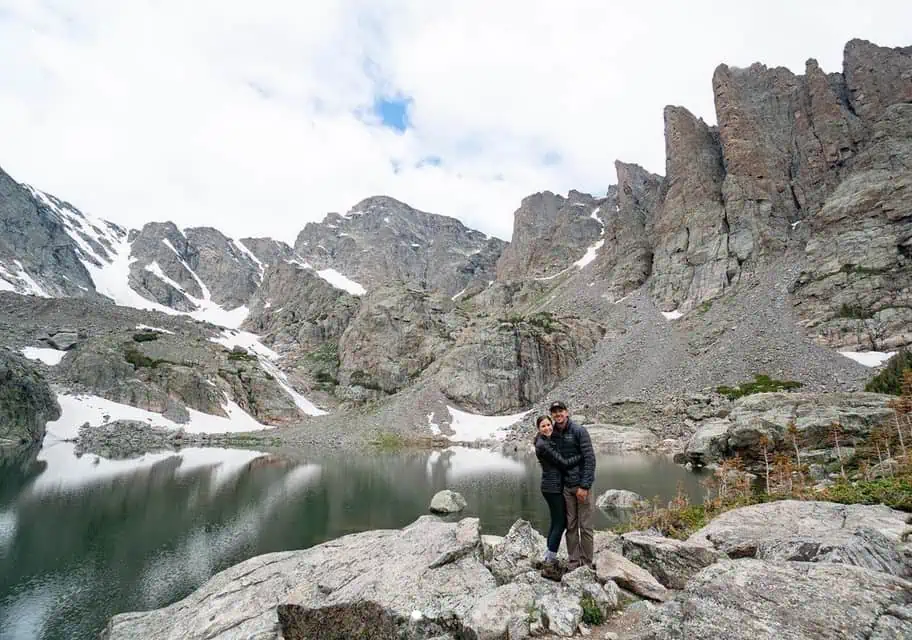From snowy trails to tropical waters to urban adventures, embrace winter with five unforgettable hikes.
I’m going to admit up front that with 21,000+ miles of trails in National Parks picking a top 5 is silly. But if you’ve seen me in a onesie, you know that’s not a deterrent. Here goes anyway, five of my favorite National Park winter hikes:
1. Rocky Mountain NP (Colorado): Sky Pond
Get ready to sweat. This hike will take you from 9,200 feet in elevation at the trailhead to just under 11,000 feet at the highest elevation. At nine miles round trip, this trail earns its reputation for difficulty. But it’s worth it when you arrive at one of the most stunning views in the National Park system. You’ll pass Loch Vale, and then ascend the challenging Timberline Falls until you get to Sky Pond where you can see The Sharkstooth, Taylor Peak, and Powell Peak. The incredible view is worth every step. Check the weather and do your research though, because depending on snow pack and temperatures, it can be unsafe and an absolute no go. But when the sun is out and the path is clear, it is unforgettable.
Join Adam and Kathryn of @adventuresofaplusk on their Hike to Sky Pond.

2. Virgin Islands National Park: Trunk Bay Snorkel Trail
For those of you who hate snow and want a winter “hike” on the beach, the Underwater Snorkel Trail at Trunk Bay on St. John is hard to beat. It’s not actually a “hike” unless you count the quarter of a mile to one of the best beaches in the Caribbean. Relax on the beach then experience one of the only underwater trails in the National Park system. It’s a great place for beginners with lots of coral and fish and informative plaques along the way. There’s a $5 fee for amenities that include showers, foot rinses, food and beverage concessions, snorkel rentals, and more. And don’t forget to use reef safe sunscreen!
If you’re interested in learning more about the protection of coral reefs, Eilish Nobe’s film The Coral Keepers takes you to the Florida Keys National Marine Sanctuary where you can learn about the ocean through the youths who are protecting it.
3. Yosemite NP (California): Yosemite Valley Loop
Yosemite during the winter is absolutely stunning, but many of the trails to El Capitan, Half Dome, Clouds Rest, and Upper Yosemite Falls can be covered in snow and impassable. You could lament the fact that winter weather is preventing you from getting to the high country, or you could take advantage of this fact and hike one of the easiest and most relaxing hikes in the entire National Park System. Yosemite is known for being overrun with people, and I have hiked this trail on three separate occasions and run into zero people attempting the same trail. This 11.5 mile trail takes you on a full loop of the entire Yosemite Valley, passing by Camp 4 and the base of El Capitan, with astounding views of Bridalveil Falls, Half Dome, and Yosemite Falls. It’s a great way to find peace and quiet in a park that is usually teeming with people.
Check out Alice Ford’s Solo Winter Adventures in Yosemite.
4. Capitol Reef NP (Utah): Cassidy Arch
This 3.1 mile out and back trail is an absolute gem of Capitol Reef National Park. For just under 600 feet of elevation gain you get to see one of the most incredible arches in the entire park. Why do it in the winter you ask? Well, in July and August temperatures can reach 90+ degrees, whereas in January and February temperatures in the mid 40s make this hike quite pleasant. Also, the park is much less busy during this time of year. As with all of these hikes, make sure you check the weather, tell someone before you go, dress for success, and leave no trace.
For more Tips on Hiking in Capitol Reef National Park, Ari and Jessi of Trekers have you covered.

5. Yellowstone NP (Wyoming): Lone Star Geyser
No list of the best winter hikes in National Parks is complete without the first National Park, Yellowstone. Admittedly, Yellowstone is more difficult to visit in the winter, and takes some research to work out the logistics. But once you get there, Lone Star Geyser is an absolute must for any Yellowstone trip. Lone Star erupts about every three hours, and can erupt up to 45 feet! It’s a 5-mile round trip hike from the trail head. Bring a thermos of coffee or tea and enjoy the spectacle. If you get cold, remind yourself that you are one of probably less than 1,000 people who get to see Lone Star Geyser erupt in the winter!
Check out Cheryl Schoss’s recommendations on traveling to Yellowstone in Winter.
Bonus hike: The National Mall, Washington, DC
It sounds counterintuitive – isn’t DC for summer vacation or school trips? – but winter is a wonderful time to see the most-visited unit in the entire national park system, with over 36 million annual visitors. Day or night, climbing the stairs of the Lincoln Memorial to read Honest Abe’s famous speeches, or strolling along the Vietnam Veterans Memorial, is a powerful experience. If you want an aerial preview of the terrain, check out the Monument Cam of the Trust for the National Mall. Winter in DC is typically crisp and comfortable for exploring the more than 30 National Park Service units in the city.
For a detailed itinerary that’s perfect for families, check out Matt and Cheryl of We’re in the Rockies on a winter trip to DC.


